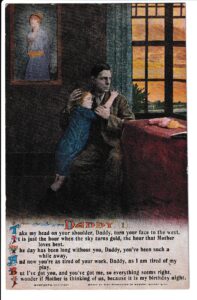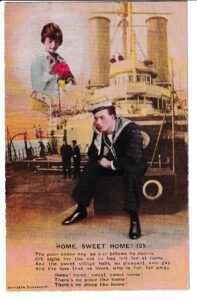



🎖️ “There’s No Place Like Home” – A Look at Bamforth & Co.’s WWI-Era Postcards
During the First World War, postcards weren’t just a way to keep in touch — they were emotional lifelines. Among the most iconic were those by Bamforth & Co., blending hand-tinted photographic scenes with sentimental verses.
Here are four poignant examples from my collection, each evoking themes of home, family, and longing.
💌 “Daddy (1)” – Birthday Reflections
A touching scene of a little girl and her father sharing a quiet birthday moment. The poem reads like a child’s plea for closeness and comfort — missing her mother, grateful for her father, and overwhelmed by the emotional weight of the day. It’s a stark reminder of how war affected not only the battlefield but the home front too.
“I wonder if Mother is thinking of us, because it is my birthday night.”
🏡 “Home, Sweet Home (3)” – The Cottage Dream
Set against a peaceful country cottage, this card portrays a soldier dreaming of simpler times. The verses idealise the cottage life — birdsong, familiarity, and peace — things far removed from the trenches.
“Give these, with contentment, much dearer than all.”
🏠 “Home, Sweet Home (1)” – A Soldier’s Return
This card shows a soldier reunited with his elderly parents, seated in a modest parlour. The verse speaks of the unmatched peace found in one’s own home — a timeless message that would have resonated deeply with soldiers returning from the chaos of war.
“Be it ever so humble, there’s no place like home.”
🌊 “Home, Sweet Home (2)” – A Sailor’s Longing
A sailor sits thoughtfully on deck, lost in memories of his village and the girl he left behind. This card captures the ache of distance and duty, the tension between honour and heartbreak.
“And the lass that he loves, who is far, far away.”
📮 Final Thoughts
These postcards are small, powerful windows into the emotional landscape of wartime Britain. They helped families stay connected and reminded soldiers what they were fighting for. Each one tells a story, not just through image and rhyme — but through the quiet spaces in between.
Whether you’re a fellow collector or just curious about WWI history, I hope these glimpses into the past resonate with you as much as they do with me.
